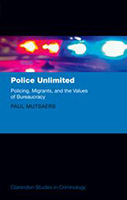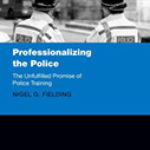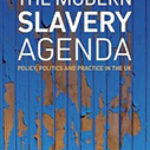Police Unlimited: Policing, Migrants, And The Values Of Bureaucracy

Author: Paul Mutsaers
Publisher: Oxford, UK: Oxford University Press, 2019. 212p.
Reviewer: Peter Grabosky | September 2019
Popular conceptions to the contrary, the gaze of anthropologists has not been limited to remote, pre-modern communities. One of my very favorite books was written by a Harvard anthropologist who in mid-career decided that he wanted to study medicine. This he did, and in his “spare time” produced an excellent study of the third year of medical education—the year of clinical rounds. Written with the insight of an anthropologist, Konner’s Becoming a Doctor (1987) is a classic in the anthropology of the professions.
As a young PhD student in anthropology, Paul Mutsaers had the good fortune to study with an academic supervisor who had high level contacts in the Dutch police service. This led to an appointment as an instructor at the police academy. Beyond his formal responsibilities, Mutsaers used his years at the academy to get to know ethnic minority students (primarily of Turkish, Moroccan, or Antillean heritage). Some shared their diaries with him, while others confided their experiences in conversations or interviews. The resulting PhD thesis-turned-book reveals how far the Dutch police have yet to go in developing a client-centred orientation.
In 2013, as part of an effort to improve the legitimacy of its police service, the Dutch government amalgamated twenty-six separate forces into one national agency. Accompanying this amalgamation was a degree of de-bureaucratization, where customer focus, fewer rules, and more street presence were the order of the day. Attempts on the part of the Dutch police to improve relations with minority populations were high on the agenda, and appear to have been made in good faith. As Mutsaers’ book grimly demonstrates, such aspirations were more easily articulated than achieved.
Mutsaers suggests that discriminatory practices remain deeply engrained in the Dutch police. Overt, unapologetic xenophobia is not uncommon. Officers refer to ethnic minorities as “target” groups, a mindset hardly compatible with customer focus. The book describes the practice of “micro deportation” where undesirable members of the public (usually, if not always, members of minority groups) are forcibly removed to the outer limits of a police district and told to keep out. Mutsaers even suggests that the Dutch police have adopted methods of psychological warfare in their communications with ethnic minorities. To this end, they were assisted by the 1st Civil-Military Interaction Command of the Dutch Army.
Not only does Mutsaers reveal racially discriminatory practices by police against civilian minorities; he also tells of abuses against those minority brethren whom the police executive had gone to such great lengths to recruit. One officer of Antillean heritage who lived and worked in a disadvantaged area of Rotterdam, and drove an old car when off duty, was reported to have been subject to identity checks on 1200 occasions during a six-year period. When he finally called this to the attention of his supervisor, he was advised to buy a new car and move to a nicer neighborhood. Another anecdote related a situation in which a Dutch officer in plainclothes was discussing a reported theft with a uniformed colleague. The plainclothes officer was accompanied by an officer of Turkish heritage, also out of uniform, and who had not been properly introduced. The exchange took place in an informal setting in the vicinity of an elevator. When the minority officer asked a question, the uniformed officer mistook him for an elevator repairman and told him to mind his own business.
It has been said that a police force should be representative of the public whom it serves. Such a principle runs aground, however, when a significant proportion of the public itself, not to mention prominent right-wing politicians and their supporters, harbor sentiments in conflict with basic principles of human rights. Mutsaers cites an ironic example, no doubt familiar to North American readers: Another plainclothes officer of Turkish descent was himself the subject of a call for service from a citizen who perceived him as suspicious.
So too are police personnel management practices tainted by discrimination. Minority officers have been encouraged to come forward with grievances. Subsequently, when they applied for promotion they were marked down for their lack of psychological resilience.
Anecdotes such as these make for compelling reading. But Mutsaers’ book has other objectives as well, and not all of these will be widely appreciated by readers. As a young scholar concerned to celebrate and to advance his discipline and to encourage further anthropological attention to the police profession, Mutsaers occasionally resorts to what might be called “anthropology-speak.” Readers should be prepared to encounter such enticing terms as “denotational indeterminacy and strategic indexicality,” not to mention “entextualization,” “interdiscursivity,” “intertextual asymmetry,” and “pretextuality.” Such exposure, fortunately, is brief.
The book quotes liberally, but at considerable length, from a variety of scholars. This may be appropriate for a PhD thesis, but is arguably excessive for a published book. One sentence runs to 52 words, which most readers may find a bit extreme.
When Mutsaers disclosed some of his findings, and it grew apparent to the Netherlands police that he was not a cheerleader, he became the target of their criticism. As they “circled the wagons,” police responded with defensive denial, and ultimately, with what Mutsaers perceived as a veiled threat of legal action. Fortunately for him, it failed to eventuate.
Solutions to some of the problems reported by Mutsaers are mutually incompatible. There are commentators on the one hand who argue that bureaucratic impersonality and over-regulation are the culprits, and that the responsible exercise of discretion, common sense, and a client-centered focus is the appropriate path. Mutsaers argues just the opposite: Bureaucracy is the solution, not the problem. Where stereotypes drive enforcement decisions, strict rules are essential. This debate is one which might lend itself to resolution through evidence-based research.
The tradition of ethnographic research on policing dates back over decades. We are indebted to William Westley, Donald Black, Jonathan Rubinstein, and others too numerous to mention for lifting the veil on police attitudes and practices. Extensive media coverage of outrageous police conduct from the Rodney King beating to the constellation of events leading to the mobilization of Black Lives Matter have led to much hand-wringing, but depressingly little in terms of reform.
This book will be of interest to a diverse readership. For this reason, it is unlikely to please all of its readers, all of the time. Aspiring anthropologists will be attracted to accounts of his early career experiences, his discussions of access to research subjects, and by his vision for the future of the profession. Social scientists who are engaged by prominent organizations will recognize another cautionary tale about the risks of speaking truth to power. Specialists in policing will be sadly familiar with the cultural and organizational impediments to reform. General readers who previously regarded The Netherlands as a model of tolerance and diversity will come away with second thoughts.
Mutsaers argues that anthropology can contribute to more democratic and humane policing. Whether his illuminating book will lead the Dutch police to welcome or resist further attention to their work remains to be seen. One wishes him every success.
Peter Grabosky, Professor Emeritus, Australian National University


